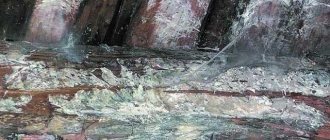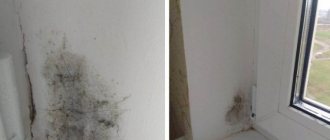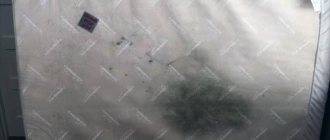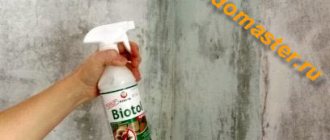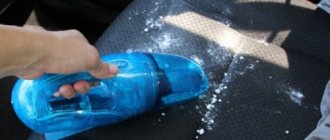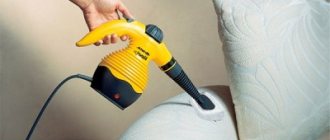Black mold and mildew appear in dark, damp conditions and lack of fresh air. Therefore, it is not surprising that dark spore plaque, as well as white mucus, cover the walls of cellars, basements and even the foundation. Today we’ll look at how to get rid of mold in the basement and fungus in the underground.
Remedies for basement mold
Basements and cellars are buried in the top layer of the earth, so dampness will be felt here constantly. This is due not only to the lack of sunlight, but also to underground water that can seep inside, as well as temperature changes that provoke the formation of condensation.
If there is poor ventilation, an unpleasant musty smell of mold will very quickly appear, which you will have to fight.
Traces of mold, fungal spores and foul odor should be removed at the first suspicion of their presence. Letting the situation take its course means facilitating the rapid proliferation of harmful microorganisms that infect everything around, causing damage not only to property, but also to human health.
There are many means to cope with the problem. Some of them are produced by the chemical industry and can easily be found on the shelves of hardware stores. Others may be at hand, and are included in recipes known to great-grandmothers - these are everyone’s favorite folk remedies.
Home remedies are only appropriate for minor areas of mold damage . When the fungus penetrates deep into the structure of the material, folk remedies are powerless. What to do in this case is to take more radical measures. It is possible to even call specialists of the appropriate profile to take care of the sanitation of the basement or foundation.
When working with products, do not forget about their harmful qualities. Therefore, you should first of all protect yourself by wearing a protective suit, gloves, a respirator, and sometimes safety glasses. You need to be wary of chemical burns on your body and inhalation of harmful fumes.
Copper sulfate and lime
The most affordable means is whitewashing surfaces with slaked lime. But if you enhance the effect of the chalk composition by adding copper sulfate, you can get rid of mold in the underground more effectively. Each product is diluted separately in a small amount of water. In this case, take 100 g of vitriol and 1 kg of lime.
It must be remembered that the lime solution is poured in a thin stream into the vitriol solution, and not vice versa.
Lemon acid
Citric acid can be called an ideal tool for removing fungus and the smell of rot when it comes to small lesions. In this case, the composition should be quite concentrated - 100 g of powder per 1 liter of water.
It is not rational to use citric acid over large areas due to the high cost of the resulting composition.
Chlorine and Whitening against mold
Disinfectants include preparations containing chlorine (the well-known one is “Whiteness”, which is used everywhere even in the food industry). You will need a fairly concentrated solution to remove the fungus in the basement.
Treating mold with white is simple:
- Pour several bottles of bleach into a bucket.
- If necessary, dilute with water according to the instructions.
- Using a broom, brush or spray bottle, generously moisten the affected surface with white.
- Dry the room.
Chlorine vapors are harmful to the nasopharynx and eyes, so precautions should be taken. At a minimum, a carbon respirator and goggles. A complete set is desirable - overalls and gas mask. There must be forced ventilation at the time of processing.
Combustible sulfur bombs
You can get rid of fungus in the basement with a smoke screen of sulfur (using a flammable bomb). It is enough to place the checker in a metal container with a stable bottom and set it on fire. first close all ventilation openings in the underground . After a few hours, the mold and smell of rot will disappear for a long time. The flammable substance itself quickly evaporates.
During the disinfection procedure (or better yet, for a couple of days), people and animals will have to leave the house.
Torch or blowtorch
Some try to fight fungal spores with fire using burners. At the moment, the product gives an effect, but does not eliminate the appearance of new rot , since it is not a disinfectant.
Hydrochloric acid
Hydrochloric acid will help get rid of mold for a long time (it can completely destroy spores) if you thoroughly treat all surfaces with it. The solution is made weakly concentrated (instructions to help), and it is used to treat not only the walls, floor and ceiling, but also shelves, racks, and containers. In this case, all food in the cellar should be removed .
Hydrochloric acid, even in low concentrations, can cause burns. Therefore, you will need fairly dense protection for all parts of the body.
The list of folk remedies can be endless, but all of them are short-term if the root cause of the formation of fungi and mold is not eliminated!
How to get rid of mold in the basement and underground of a private house
It is not enough to choose one of the means to remove rot in the basement and cellar - you also need to properly prepare the room for disinfection, as well as pay attention to waterproofing and establish a ventilation system.
Cleaning (room preparation)
Before processing the basement, it must be prepared.
- All food and items stored in the basement are removed . The shelves are removed and taken outside along with the racks. The same is done with containers. If the floor of the room is covered with boards, they should also be removed.
- All wooden elements must be thoroughly dried outside under the sun. Therefore, it makes more sense to carry out disinfection in the summer, when it is a dry, windless day. After this, you need to treat the wooden surfaces with disinfectants in 2-3 layers. If the material is significantly susceptible to damage, it is better to get rid of shelves and racks, replacing them with new, pre-disinfected ones.
- Metal structures and containers are washed, cleaned of rust and disinfected. Then they should be painted using a pre-bactericidal primer.
- Concrete and brick walls of the cellar are thoroughly cleaned with a wire brush . All rot stains must be removed. If the walls are plastered, it is recommended to knock down the layer of plaster riddled with spores.
- In the version with an earthen floor, it is necessary to remove the top layer of soil in which spore fungi can live.
Having finished with the preparation, begin to disinfect all surfaces using a whitewash brush. In versions with copper sulfate, slaked lime and chlorine-containing preparations, it is convenient to distribute the solution over surfaces using a spray bottle. For clarity, you can watch the video.
Waterproofing, treatment and wall covering
The main reason for the development of mold is considered to be dampness, so you should worry about waterproofing the walls of the basement. Before starting work, the basement should be thoroughly dried. To do this, you can use electric fireplaces or an industrial hair dryer.
- After inspecting the walls, remove crumbling surfaces and open up existing cracks, which should then be sealed.
- You can coat it with special solutions such as Penetron or Aquastop; these products can stop water from penetrating into the basement.
- Depending on the depth of the defect, a sand concrete solution or plaster for wet rooms is used.
- For reliability, you can apply an additional layer of cement putty.
- After allowing the composition to dry, treat the walls and ceiling with an antifungal agent.
A good insulation solution is a second wall, which should be 3-5 cm away from the main wall to eliminate the risk of condensation. A moisture-resistant material is used as a false wall, in which several holes must be made for ventilation.
It is advisable to fill the floor with a concrete screed and ensure that no gaps form in it. Waterproofing of the floor will be provided by a drainage layer, for which it is best to use expanded clay.
If water constantly penetrates into the basement, only external waterproofing will help; the problem cannot be solved from the inside.
Ventilation against dampness
The cellar ventilation system is installed during the construction of the house; in theory, it should completely remove dampness from the basement. If it does not cope with its function, then it should be improved a little . You can remove 2 additional pipes from the room - one at floor level, the other under the ceiling.
Another option is holes in the door leading to the basement, or cracks around its perimeter. All this will ensure air movement, bringing a fresh flow inside. You can also install forced exhaust.
How to fill the underground from dampness
Builders do not have a clear opinion regarding filling the underground space.
Some believe that in this way you can make the house much warmer, others, on the contrary, believe that this will lead (especially with high groundwater) to rotting of wooden boards and floor elements. Because moisture from the soil will seep out more intensely and settle as condensation on the tree.
In our opinion, materials such as slag and expanded clay are much more suitable than clay.
How to remove dampness in the basement and underground of a private house:
- To prevent the filler from getting wet on the ground, waterproofing (roofing material, rubemast, glass insulation, or, in extreme cases, dense reinforced greenhouse film) is laid to cut off groundwater.
- The edges of the waterproofing are turned up vertically so that it is between the filling material and the foundation base.
If you decide to fill with clay, then this should be done according to the rules that are used when constructing a clay castle. To put it briefly, they take fatty clay, leave it in a heap next to the house for the winter, then use it by laying crumpled clay under the house in the underground space and compacting it.
This minimizes the moisture conductivity of the clay compared to ordinary clay.
Preparation
First you need to prepare a room for removing the fungus.
No matter what product is used to remove spores, the room must be completely cleaned. Take out all the seams, food and everything else that is in your cellar. Only clean walls and ceilings should remain in the basement. Everything will have to be endured.
If the shelves are also covered with a black or green coating, leave them and treat them too.
Only after clearing the basement of all items can it be processed.
What to do with the foundation if groundwater passes nearby
Often the reason for the development of rot is groundwater penetrating into the underground, which is located quite close to the surface of the earth. This factor can be eliminated by a number of actions. If a drainage system was not provided outside, then there will be water on the floor in the basement .
The groundwater level under the foundation of a house can be artificially lowered by installing a drainage system outside. It should be buried below the expected groundwater level, while providing layering . This will prevent moisture from penetrating into the underground and will keep the ground around the house dry. Then fungus is unlikely to appear on the foundation.
Vacuum cleaner
Regularly cleaning your basement with a HEPA (High efficiency particulate air) vacuum cleaner helps reduce the development of allergic reactions that occur due to toxins released by spores and also reduces the amount of mold.
When you vacuum with a regular vacuum cleaner, most of the spores pass through the filtration process and are released back into the air. This happens because they are too small for regular filters.
But when you vacuum with HEPA, the spores are caught in the filter and remain inside.
In addition to reducing mildew, this vacuum also removes other types of allergens.
This procedure should be carried out throughout the house, not just in the basement, at least once a week to minimize mold.
How to get rid of fungus in the underground of a wooden house
The smaller the basement, the more difficult it is to ensure normal air circulation in it. Therefore, special attention is paid to openings in underground walls . They must be end-to-end with access to the street and located opposite each other at a height of at least 40 cm from ground level. The optimal ones are squares with sides of 15-20 cm, covered with mesh (to prevent the penetration of rodents and debris).
Treating a small room with disinfectants containing harmful fumes is dangerous for humans . Therefore, in order to get rid of mold in the basement of a wooden house, it is better to use slightly different methods of combating mold, determining how to eliminate the problem.
- The same smoke bombs as described above will do.
- You can use hydrochloric acid, but in a different way - pour it over table salt. In this case, the container should be glass or ceramic, and it should be placed on the floor in the center of the room.
- White moss powder absorbs harmful spores well. It is poured into metal containers and placed in the corners of the basement.
In a wooden house, using an electric fireplace to dry the underground room is risky due to the possibility of fire. The option of a professional hairdryer in a small basement is also out of the question. Here you can apply popular recommendations - lay out heated ceramic bricks in the underground on the ground along the walls . They absorb moisture well and can be heated several times.
If possible, whitewashing the inside of the walls can help. You can also mix lime with underground soil.
How to get rid of mold on boards and joists
If the damage is not significant, watch the video instructions on YouTube. In case of serious areas of rot, it is recommended to cut out the boards with joists and replace them with new ones treated with bioprotection.
How to Get Rid of Mold in a Garage Basement
Some car owners make their garage multifunctional by arranging basements there to store food supplies for the winter (especially those who live in apartment buildings do this). Typically, such cellars are an addition to the inspection hole and do not take up much space. Therefore, a slightly different method is required to remove fungus and mold.
Treatment of the garage against mold in the basement is carried out by all available means described above, BUT:
- The use of hydrochloric acid will have to be avoided , since its vapors can damage the metal parts of the machine and tools.
- It is also risky to use chlorine-containing products in small rooms without ventilation.
- Burners and smoke bombs are excluded due to the proximity of fuels and lubricants and rags.
An effective option to get rid of mold in a garage basement is lime whitewash. It is also recommended to spread slaked lime on the shelves and floor of the cellar - it absorbs moisture well and neutralizes fungal spores.
Reviews
Pavel, 45 years old
I recently discovered black mold in the corners of my basement. It turned out that condensation was accumulating on the walls. We had to urgently dry the room, and we got rid of the mold with a sulfur bomb. A very effective remedy.
Igor, 37 years old
Mold developed on the potatoes in the cellar because it was too warm. We ventilated the cellar and adjusted the ventilation. Of course, I had to throw out some of the potatoes. For prevention, all the walls were coated with bleach.
Mold and mildew in the basement of an apartment building
Problems with mold in the basement of a private house are resolved by the owners themselves. But what should residents of apartment buildings do, how can they get rid of fungus? It will be difficult for residents to cope with the problem on their own - the areas are too vast. In addition, utility services that receive rent are responsible for the technical condition of the house .
They are required to regularly inspect the technical premises located under the house and assess their condition. If fungi are detected, appropriate measures must be taken with the involvement of sanitary sanitation services.
If this does not happen, and the mold continues to develop, residents can collect a collective statement to take action and submit it to the head of the management company (MC), sending a copy to the housing inspectorate . If you do not respond, you can file a complaint in other places:
- To the management company itself
- To the district/city administration (The most ineffective government agency)
- To the State Housing Inspectorate (the most effective government agency after the court)
- To the District Prosecutor's Office
- To the Court (Long, nervous, and also difficult without a lawyer)
- To another management company (If nothing helps, is there any point in continuing to remain in the same management company? You can try to change it).
Where should you not complain?
- To the police. They will refuse to initiate a criminal case with a note stating that you have a civil dispute.
- There is no need to write a complaint to the regional prosecutor's office until you have written to the district prosecutor's office. The complaint will be sent down, and you will only waste your time. Contact the top only if the bottom does not help.
- To the administration of the president, governor, etc. The same situation as in the previous case. Go only if the district administration, the prosecutor's office and the State Property Committee did not help.
- Deputies. They simply forward the complaint to the appropriate authority. They are not capable of anything else.
- Senior at home. This is a person who doesn't decide anything.
Does mold often appear on the foundation of your home? This is either fungus from the basement starting to penetrate outside, or the drainage system around the house is broken. If a private owner can still cope with a similar situation himself, using recommendations regarding mold in the basement of a private household (described above), then the apartment building is under the jurisdiction of the housing and communal services, which should worry about disinfecting the foundation.
In a situation where mold has appeared on the foundation, special services are involved that have the appropriate equipment to dry the foundation and treat it. They also use stronger antiseptics.
What is mold afraid of?
It is easier to remove mold and mildew when measures are taken to prevent their occurrence. Therefore, prevention for rooms with high humidity should be mandatory so as not to guess why rot appeared.
What mold is afraid of:
- The specific nature of basements contributes to the appearance of humidity there. Therefore, it should be monitored regularly. You can prevent the appearance of moisture with the slaked lime already described above, which is recommended to be poured on the floor or kept in open containers on shelves.
- Lime mixed with sand should be poured into the boxes where food preparations are stored.
- During cold and wet seasons, you can periodically burn sulfur , the vapors of which will prevent rot from developing.
- Ventilation is of great importance. Don't rely on the ventilation system alone. It is recommended to leave the doors to the basement open for several hours from time to time .
- The white moss powder mentioned above can be used for preventive purposes by placing small jars on the shelves. In this case, it is necessary to change it periodically.
Don't wait for mold to appear in the basement. Treatment of walls, ceilings, floors, as well as racks, shelves, and drawers should be carried out every summer, preparing the room for storing new products.
Prevention measures
Prevention is always easier than dealing with an existing problem. Therefore, it is better to invest time and money in advance to prevent the appearance of fungus.
Mold under the floor: before and after treatment
Prevention measures:
- Organize underground ventilation to prevent dampness.
- Waterproof and insulate the entire outer surface of the foundation.
- Be sure to ensure that excess moisture does not appear under the floor: check the subfloor at least once a year (in winter or early spring). If you suddenly feel damp, you need to immediately increase ventilation.
If these rules are followed, risks are significantly minimized, and even if it does appear, it will happen more slowly and on a smaller scale.
Harm from mold
Fungal mold spores are a pathogenic microflora that can cause great harm not only to the room in which they develop, but also to people and their pets.
For living organisms
The fungus multiplies not only by moving on surfaces, its spores fly in the air and can enter the body through inhalation. Going down into the cellar, the housewife can introduce mold spores into the house, thereby endangering her household. Their penetration into a living organism can also occur from the hands during cooking or eating.
An annoying dry cough, causeless headaches, aching joints, allergic manifestations, asthmatic syndrome - this is just a small list of diseases that can develop under the influence of fungal spores.
Types and signs of fungal formations
It's hard to believe, but the mold that can create so many problems is just a single-celled fungus, or rather, an entire colony of single-celled fungus. It is almost always present in the air, but in an inactive state, waiting for its hour, when it becomes sufficiently humid and warm.
The material for mold is absolutely unimportant; it settles absolutely everywhere.
Probably everyone has seen the bluish color of wood - this is also a mold fungus. Bluish mold not only affects the appearance of the wood, but also penetrates inside and creates passages for water. And then it is almost impossible to defeat mold. Subsequently, such a tree will be corroded from the inside, losing not only its beauty, but also its strength.

